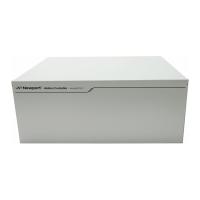XPS Unified Programmer’s Manual
7.2.1.246 PositionerExcitationSignalCorrectorOutSet
Name
PositionerExcitationSignalCorrectorOutSet – Sets and activates the signal of
excitation that is inserted at corrector output.
Input tests
- Refer to section 7.1: “Input Tests Common to all XPS Functions”.
- Valids object type: (-8)
- Is secondary positioner or has a secondary positioner: (-8)
- Checks frequency (must ≥0.1 and ≤0.5/CorrectorISRPeriod): (-17)
- Checks excitation time (must ≥4 * CorrectorISRPeriod): (-17)
- Checks signal amplitude [-Acceleration (Velocity or Voltage) limit to Acceleration
(Velocity or Voltage) limit]: (-17)
- Checks type of signal (0, 1, 2 or 3): (-17)
- Valids positioner name: (-18)
- Checks group status (must be READY): (-22)
- Valids control loop type: (-24)
Description
The excitation signal functionality generates a typical signal (a sine, a blank noise or an
echelon signal) that the controller sends to motors to excite the system. In measuring the
output signal of the excited system, we can determine some system characteristics, like
the system transfer function.
The excitation signal functionality is only available with the stages controlled in
acceleration (acceleration control, ex: brushless / linear motors), velocity (velocity
control) or in voltage (voltage control). It does not exist with the stages controlled in
position (ex: stepper motors).
The excitation-signal function PositionerExcitationSignalCorrectorOutSet can be
executed only when the positioner is in “READY” state. When the excitation-signal
process is in progress, the positioner is in the “ExcitationSignal” state. At the end of the
process, the positioner returns to “READY” state (see group state diagram).
The PositionerExcitationSignalCorrectorOutSet function sends an excitation signal
to the motor for a brief time. This function is allowed for “PIDFFAcceleration”,
“PIDFFVelocity” or “PIDDualFFVoltage” control loops. The parameters to configure
are signal type (0:sine, 1:echelon,2:random-amplitude,3:random-pulse-width binary-
amplitude, integer), frequency (Hz, double), amplitude (acceleration, velocity or voltage
unit, double) and during time (seconds, double).
The function effective parameters for each mode are: (here: Limit means
AccelerationLimit, VelocityLimit or VoltageLimit)
- Sine signal mode: Frequency (≥0.1 and ≤0.5/CorrectorISRPeriod), Amplitude (>0
and ≤Limit), Time (≥4 * CorrectorISRPeriod)
- Echelon signal mode: Amplitude (>0 and ≤Limit, or <0 and ≥-Limit), Time(≥4 *
CorrectorISRPeriod)
+ During Time: Signal = Amplitude
+ End of Time: Signal = 0
- Random-amplitude signal mode: Amplitude (>0 and ≤Limit), Time(>0), Frequency
(≥0.1 and ≤0.5/CorrectorISRPeriod)
EDH0373En1023 — 01/18 380

